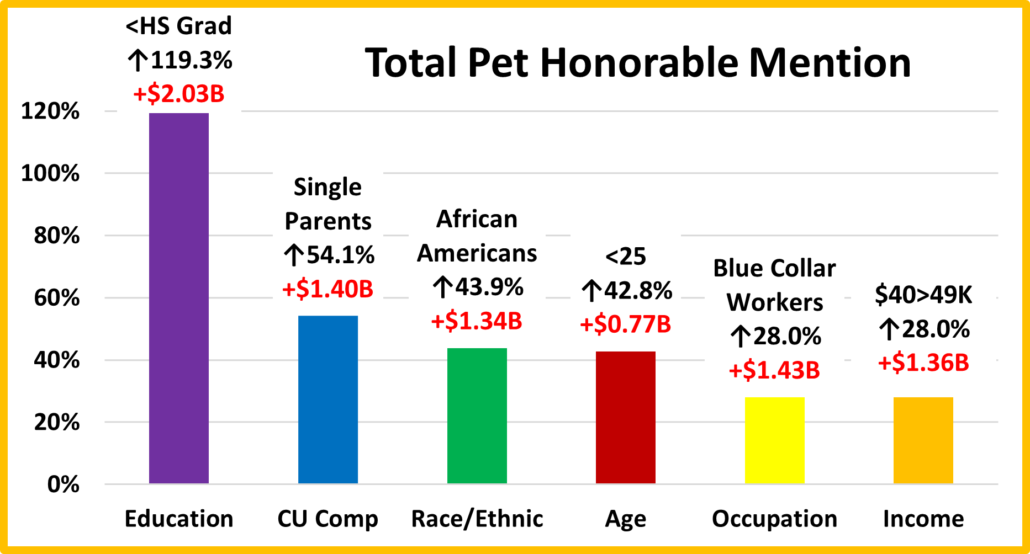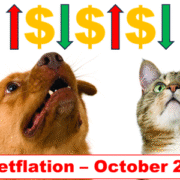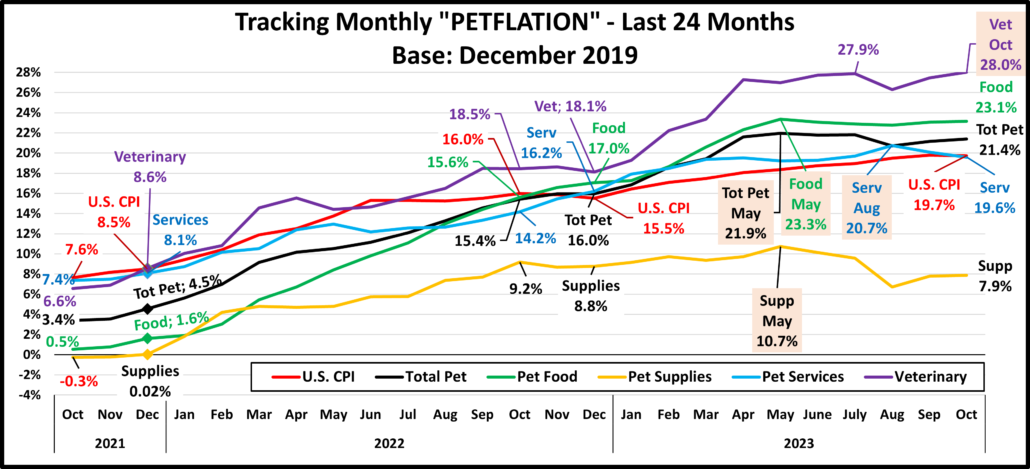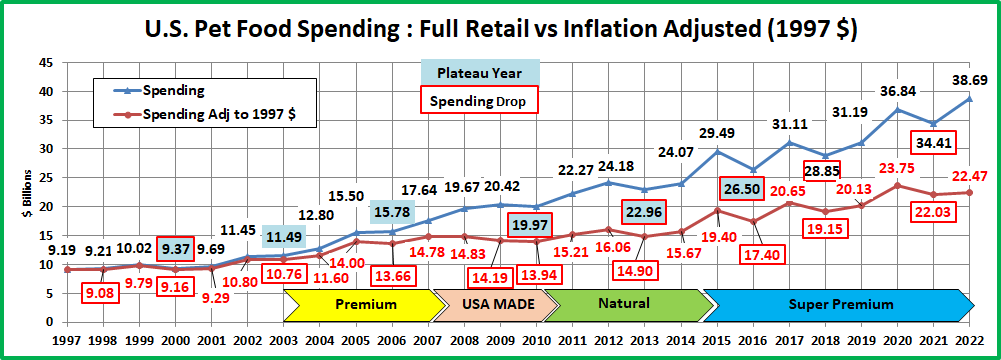Petflation 2023 – November Update: Down to +4.3% vs 2022
Inflation continues to slow but is still far above the target rate. The huge YOY increases in the monthly Consumer Price Index peaked in June 2022 at 9.1% then began to slow until turning up in Jul/Aug 2023. Prices dropped in Oct & Nov and the November CPI fell to +3.1% from +3.2% vs 2022. Grocery inflation also continued to slow. After 12 straight months of double-digit YOY monthly increases, grocery inflation is now down to +1.7%, 9 consecutive months below 10%. As we have learned, even minor price changes can affect consumer pet spending, especially in the discretionary pet segments, so we will continue to publish monthly reports to track petflation as it evolves in the market.
Petflation was +4.1% in December 2021 while the overall CPI was +7.0%. The gap narrowed as Petflation accelerated and reached 96.7% of the national rate in June 2022. National inflation has slowed considerably since June 2022, but Petflation generally increased until June 2023. It passed the National CPI in July 2022 and at 4.3% in November, it is still 38.7% above the national rate of 3.1%. We will look deeper into the numbers. This and future reports will include:
- A rolling 24 month tracking of the CPI for all pet segments and the national CPI. The base number will be pre-pandemic December 2019 in this and future reports, which will facilitate comparisons.
- Monthly comparisons of 23 vs 22 which will include Pet Segments and relevant Human spending categories. Plus
- CPI change from the previous month.
- Inflation changes for recent years (21>22, 20>21, 19>20, 18>19)
- Total Inflation for the current month in 2023 vs 2019 and now vs 2021 to see the full inflation surge.
- Average annual Year Over Year inflation rate from 2019 to 2023
- YTD comparisons
- YTD numbers for the monthly comparisons #2>4 above
In our first graph we will track the monthly change in prices for the 24 months from November 21 to November 23. We will use December 2019 as a base number so we can track the progress from pre-pandemic times through an eventual recovery. This chart is designed to give you a visual image of the flow of pricing. You can see the similarities and differences in segment patterns and compare them to the overall U.S. CPI. The current numbers plus yearend and those from 12 and 24 months earlier are included. We also included and highlighted (pink) the cumulative price peak for each segment. In November, Pet prices were down from last month overall and in all segments but Food & Vet Services.
In November 21, the CPI was +8.2% and Pet prices were +3.5%. Like the CPI, prices in the Services segments generally inflated after mid-2020, while Product inflation stayed low until late 21. In 22 Petflation took off. Food prices grew consistently but the other segments had mixed patterns until July 22, when all increased. In Aug>Oct Petflation took off. In Nov>Dec, Services & Food prices continued to grow while Vet & Supplies prices stabilized. In Jan>Apr 23, prices grew every month except for 1 dip by Supplies. In May Products prices grew while Services slowed. In June/July this was reversed. In August all but Services fell. In Sep/Oct this was reversed. In November, all but Food & Veterinary Services fell driving down Total Pet prices, -0.2% vs October. Petflation has been above the CPI since Nov 22.
- U.S. CPI – The inflation rate was below 2% through 2020. It turned up in January 21 and continued to grow until flattening out in Jul>Dec 22. Prices turned up Jan>Sep, then dipped in Oct/Nov, but 35% of the 19.5% increase in the 47 months since December 2019 happened in the 6 months from January>June 2022 – 13% of the time.
- Pet Food – Prices were at or below Dec 2019 levels from Apr 20>Sep 21. They turned up and grew, peaking in May 23. In Jun>Aug they dipped but grew again in Sep>Nov. 93% of the 23.2% increase has occurred since 22.
- Pet Supplies – Supplies prices were high in Dec 19 due to added tariffs. They then had a “deflated” roller coaster ride until mid-2021 when they returned to Dec 19 prices and essentially stayed there until 2022. They turned up in January and hit an all-time high, beating the 2009 record. They plateaued Feb>May, grew in June, flattened in July, then turned up in Aug>Oct setting a new record. Prices stabilized in Nov>Dec but turned up in Jan>Feb 23, a new record. They fell in March, peaked at a new record in May, fell in Jun>Aug, grew in Sep>Oct, then fell in Nov.
- Pet Services– Normally inflation is 2+%. Perhaps due to closures, prices increased at a lower rate in 2020. In 2021 consumer demand increased but there were fewer outlets. Inflation grew in 2021 with the biggest lift in Jan>Apr. Inflation was stronger in 2022 but it got on a rollercoaster in Mar>June. It turned up again July 22>Mar 23 but the increase slowed to +0.1% in April. Prices fell -0.3% in May, turned up again, peaking in Aug, then fell in Sep>Nov.
- Veterinary – Inflation has been consistent. Prices turned up in March 20 and grew through 21. A surge began in December 21 which put them above the overall CPI. In May 22 prices fell and stabilized in June causing them to fall below the National CPI. However, prices rose again and despite some dips they have stayed above the CPI since July 22. In 23 prices grew Jan>May, stabilized Jun>Jul, fell in Aug, then grew Sep>Nov to a new high.
- Total Pet – Petflation is a sum of the segments. In Dec 21 the price surge began. In Mar>Jun 22 the segments had ups & downs, but Petflation grew again from Jul>Nov. It slowed in Dec, grew Jan>May 23 (peak), fell Jun>Aug, grew in Sep/Oct, then fell in Nov. Except for 5 monthly dips, prices in all segments increased monthly Jan>Jun 23. In Jul/Aug there 5 more dips, 2 in Sep/Oct, then 2 big ones in Nov. Petflation has been above the CPI since Nov 22
Next, we’ll turn our attention to the Year Over Year inflation rate change for November and compare it to last month, last year and to previous years. We will also show total inflation from 21>23 & 19>23. Petflation fell again to 4.3% in November, but it is still almost 1.4 times the National rate. The chart will allow you to compare the inflation rates of 22>23 to 21>22 and other years but also see how much of the total inflation since 2019 came from the current pricing surge. Again, we’ve included some human categories to put the pet numbers into perspective.
Overall, Prices were -0.2% from October but were +3.1% vs November 22, down from +3.2% in October. Grocery inflation is down again, to +1.7% from +2.1%. 5 of 9 categories had a price decrease from last month – National CPI, Total Pet, Groceries, Pet Supplies & Services. There were only 2 in October. That’s 3 months in a row for Pet Services. The national YOY monthly CPI rate of 3.1% is only 44% of the 21>22 rate. The 22>23 inflation rate is below 21>22 for all categories for the 3rd consecutive month. In our 2021>2023 measurement you also can see that over 65% of the cumulative inflation since 2019 occurred in only 4 segments – Total Pet, Pet Food, Pet Supplies and Veterinary – All Pet. We should also note that the segments with the lowest percentages are Haircuts, Pet Services and Medical Services. Service Segments have generally had higher inflation rates so there was a smaller pricing lift in the recent surge. Services expenditures account for 61.8% of the National CPI so they are very influential. We also see that Pet Products have a very different pattern. The 21>23 inflation surge provided 97.8% of their overall inflation since 2019. This happened because Pet Products prices in 2021 were just starting to recover from a deflationary period.
- U.S. CPI– Prices are -0.2% from October. The YOY increase is 3.1%, down from 3.2%. It peaked at +9.1% back in June 2022. The targeted inflation rate is <2% so we are still 55% higher than the target. After 12 straight declines, we had 2 lifts, then a stable month and now 2 consecutive drops – good news! The current inflation rate is 56.3% below 21>22 but the 21>23 rate is still 10.5%. That is 54% of the total inflation since 2019, but down from 57% last month.
- Pet Food– Prices are +0.01% vs October and +5.6% vs November 22, down from 6.5%. However, they are still 3.1 times the Food at Home inflation rate. The YOY increase of 5.6% is being measured against a time when prices were 16.3% above the 2019 level, but that increase is still 1.5 times the pre-pandemic 3.7% increase from 2018 to 2019. The 2021>2023 inflation surge has generated 96.9% of the total 22.9% inflation since 2019.
- Food at Home – Prices are down -0.5% from October. The monthly YOY increase is 1.7%, down from 2.1% in October and radically lower than Jul>Sep 2022 when it exceeded 13%. The 25.4% Inflation for this category since 2019 is 31% more than the national CPI and remains 2nd to Veterinary. 54% of the inflation since 2019 occurred from 2021>2023. The pattern mirrors the national CPI, but we should note that Grocery prices began inflating in 2020>2021 then the rate accelerated. It appears that the pandemic supply chain issues in Food which contributed to higher prices started early and foreshadowed problems in other categories and the overall CPI tsunami.
- Pets & Supplies– Prices were down -0.5% from October and -1.2% vs November 2022. They still have the lowest increase since 2019. As we noted, prices were deflated for much of 2021. However, even with recent price drops the 2021>2023 inflation surge accounted for 82% of the total price increase since 2019. They reached an all-time high in October 2022 then prices deflated. 3 months of increases pushed them to a new record high in February. Prices fell in March, bounced back in Apr/May to a new record high, fell in Jun>Aug, grew in Sep>Oct, then fell in November.
- Veterinary Services – Prices are up +1.0% from October. They are +9.0% from 2022, again the highest rate in the Pet Industry. Plus, they are still the leader in the increase since 2019 with 30.0% compared to Food at home at 25.4%. For Veterinary Services, relatively high annual inflation is the norm. The rate did increase during the current surge so 70% of the 4 years’ worth of inflation occurred in the 2 years from 2021>2023.
- Medical Services – Prices turned sharply up at the start of the pandemic but then inflation slowed and fell to a low rate in 20>21. Prices grew 0.3% from October but are -0.9% vs 22. Prices have now deflated for 7 straight months. Medical Services are not a big part of the current surge as only 39% of the 2019>23 increase happened from 21>23.
- Pet Services – Inflation slowed in 2020 but began to grow in 2021. November 23 prices were -2.1% from October and only +1.4% vs 22, which is down 70% from 4.7% last month and 84% lower than 8.0% in March. Now, only 50% of their total 17.8% inflation since 2019 occurred from 21>23.
- Haircuts/Other Personal Services – Prices are up 0.3% from October and +3.9% from 2022, down sharply from 5.0% last month. Inflation has been rather consistent as 51% of the inflation from 19>23 happened from 21>23.
- Total Pet– Petflation is now 64% lower than the 21>22 rate, but still 1.4 times the U.S. CPI. For November, +4.3% is the 4th highest rate since 1997 (2022: 12.0%; 2008: 10.0%; 2007: 5.3%). Vs October, prices fell for Supplies & Services so Total Pet was -0.3%. An Oct>Nov drop has only happened in 6 of the last 24 years so it was a surprise. Veterinary & Food are still the Petflation leaders, but all segments have an influence. Pet Food has been immune to inflation as Pet Parents are used to paying a lot, but inflation can reduce purchase frequency in the other segments.
Now, let’s look at the YTD numbers
The increase from 22>23 is the biggest for 2 of 9 categories – both Pet, Pet Food & Veterinary. The 22>23 rates for Haircuts, Pet Services & Total Pet are slightly below 21>22. However, the CPI, Pet Supplies, Medical Services and Food at Home are significantly down from 21>22. The average annual increase since 2019 is 4.5%+ for all but Medical Services (2.7%) and Pet Supplies (2.5%).
- U.S. CPI – The current increase is down 48% from 21>22 and 6.7% less than the average increase from 2019>2023, but it’s 72% more than the average annual increase from 2018>2021. 66% of the 19.2% inflation since 2019 occurred from 2021>23. Inflation is a big problem that started recently.
- Pet Food – Strong inflation continues with the highest 22>23 & 21>23 rates on the chart. Deflation in the 1st half of 2021 kept YTD prices low then prices surged in 2022. 96% of the inflation since 2019 occurred from 2021>23.
- Food at Home – The 2023 YTD inflation rate has slowed but still beat the U.S. CPI by 29%. You can see the impact of supply chain issues on the Grocery category as 69% of the inflation since 2019 occurred from 2021>23.
- Pets & Pet Supplies – Prices fell in November and the YTD inflation rate is down to 2.9%. Prices deflated significantly in both 2020 & 2021 which helped to create a very unique situation. Prices are up 10.2% from 2019 but 105% of this increase happened from 2021>23. Prices are up 10.7% from their 2021 “bottom”.
- Veterinary Services – They are still #1 in inflation since 2019 but they have only the 2nd highest rate since 2021. At +6.5%, they have the highest average annual inflation rate since 2019. Inflation was high and consistent, around 4% from 2019>2021. It took off in 2022. Regardless of the situation, strong Inflation is the norm in Veterinary Services.
- Medical Services – Prices went up significantly at the beginning of the pandemic, but inflation slowed in 2021. In 2023 prices have generally been deflating and are now at -0.3% YTD, the only current deflation in any segment.
- Pet Services – May 22 set a record for the biggest year over year monthly increase in history. Prices fell in June but began to grow again in July, reaching record highs in Sep>Apr 23. The January 2023 increase of 8.4% set a new record. Prices have dropped Sep>Nov and YTD November fell to 6.1% from 6.6% in October and 7.0% in August. Their price surge started in 2021 when inflation jumped to 4.7% from 2.5% in 2019 & 2020.
- Haircuts & Personal Services – The services segments, essential & non-essential, were hit hardest by the pandemic. After a small decrease in March 22, prices turned up again. Since 2021 inflation has been a consistent 5+%, 89% higher than 18>19. Consumers are paying 21% more than in 2019, which usually reduces the purchase frequency.
- Total Pet – There were two patterns. After 2019, Prices in the Services segments increased, and the rate grew into 2021. Pet products – Food and Supplies, took a different path. They deflated in 2020 and didn’t return to 2019 levels until mid-year 2021. Food prices began a slow increase, but Supplies remained stable until near yearend. In 2022, Food and Supplies prices turned sharply up. Food prices grew until Jun>Aug 23. Supplies prices stabilized Apr>May, grew Jun>Oct, fell in Nov, rose in Dec>Feb, fell in Mar, rose in Apr>May then fell in Jun>Aug. Both grew Sep/Oct. In November, Food was stable & Supplies fell. The Services segments have also had ups & downs but have generally inflated. The net is a YTD Petflation rate vs 2022 of 8.3%, about double the CPI. In May 22 it was 5.8% below the CPI.
Petflation is slowing, but still strong. Petflation dropped from 5.2% in October to 4.3% in November. This is 64% below the record 12.0% set in November 22, but still the 4th highest rate for the month. The last 6 months have all been <10% but 9 of 16 have been 10+%. The current 4.3% rate is still 2.7 times the 1.6% average rate from 2010>2021 and also 1.4 times the national rate. There is no doubt that the current pricing tsunami is a significant event in the history of the Pet Industry, but will it affect Pet Parents’ spending. In our demographic analysis of the annual Consumer Expenditure Survey which is conducted by the US BLS with help from the Census Bureau we have seen that Pet spending continues to move to higher income groups. However, the impact of inflation varies by segment. Supplies is the most affected as since 2009 many categories have become commoditized which makes them more price sensitive. Super Premium Food has become widespread because the perceived value has grown. Higher prices generally just push people to value shop. Veterinary prices have strongly inflated for years, resulting in a decrease in visit frequency. Spending in the Services segment is the most driven by higher incomes, so inflation is less impactful. This spending behavior of Pet Parents suggests that we should look a little deeper. Inflation is not just a singular event. It is cumulative. Total Pet Prices are up 4.3% from 2022 but they are up 16.9% from 2021 and 21.5% from 2019. That is a huge increase in a very short period. It puts tremendous monetary pressure on Pet Parents to prioritize their expenditures. We know that the needs of their pet children are always a high priority but let’s hope for a little relief – stabilized prices and even deflation. This is not likely in the Service segments, but it has happened before in Products. Pet Food inflation has slowed for 7 straight months, and Supplies prices have deflated in 3 of the last 4 months. It’s just a start. Let’s hope that it accelerates “down”.





















































